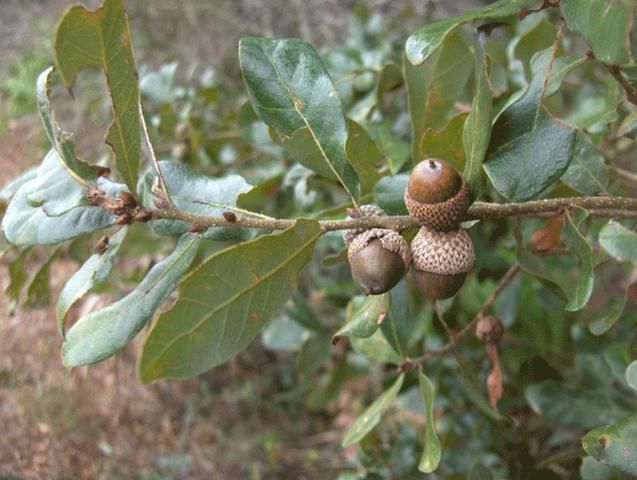Family
Fagaceae, beech and oak family.
Genus
Quercus comes from the Latin name for "oak." It is formed from two Celtic words: quer ("beautiful"), and cuez ("tree").
Species
The species name, chapmanii, is after the physician and botanist A. W. Chapman (1809–1899), the first person to describe this species in his book titled "Flora of the Southeastern United States."
Common Names
Chapman Oak, Chapman White Oak, Scrub Oak
The common name Chapman oak is a literal translation of its scientific name. Some may have added the word "white" to form the name "Chapman white oak" because it belongs to the white oak group, as opposed to the red oak group. The common name "scrub oak" is associated with this tree because it occurs in dry scrub habitats.

Credit: Homer Edward Price, (CC BY 2.0)
Description
This native oak is naturally found in the dry, xeric habitats of sandy ridges and coastal dunes throughout most of Florida and coastal Alabama, Georgia, and the southern portion of South Carolina. It is considered to be a small-statured tree rarely exceeding heights of 30 feet. Leaves are simple and alternate, and range from 1½ to 3½ inches long. Their shape can range from obovate or oblong, with the broadest part of the leaf below the rounded apex but above the middle portion. Leaves may exhibit a waviness or become slightly lobed, and the margins or edges are smooth. The topside of the leaf is a shiny dark green and the underside is a dull light green to almost yellow, with pubescence (tiny hairs) along the midvein. The tardily deciduous leaves turn yellow or red in the fall and winter months, and by spring are no longer present on the tree. Bark is a light gray to grayish brown color and has scaly plates. Each year acorns just under ½ inch in size are produced in pairs, and a gray cup encloses the top half of each brown nut.
Allergen
All members of the Quercus genus are known to produce large amounts of pollen, making both deciduous and evergreen oaks highly to extremely allergenic.
Applications
Horticultural
The Chapman oak is not grown for the same qualities attributable to many other oak species. However, at only 6 to 30 feet tall it can make for a quaint specimen during the fall and winter months when its leaves turn attractive shades of red and yellow, or in the spring when long catkins appear alongside its new growth.
Medicinal
Members of the Quercus genus contain a chemical known as tannin, which is the active chemical in most medicine made from oaks. Experiments have shown that this compound contains properties that prevent viruses, infections, and tumors. However, some tannins have been suspected of being carcinogenic.
Wildlife
Acorns of the Chapman oak provide a significant source of food to a variety of wildlife, ranging from birds to large mammals.
References
Austin, D. F. 2004. Florida ethnobotany. Boca Raton, FL: CRC Press.
Godfrey, R. K. 1988. Trees, shrubs, and woody vines of Northern Florida and adjacent Georgia and Alabama. Athens, GA: The University of Georgia Press.
Little, E. L. 2005. National Audubon Society field guide to trees, Eastern region. New York, NY: Alfred A. Knopf, Inc.
Nelson, G. 1994. The trees of Florida: A reference and field guide. Sarasota, FL: Pineapple Press.
Ogren, T. L. 2000. Allergy-free gardening: The revolutionary guide to healthy landscaping. Berkeley, CA: Ten Speed Press.
Osorio, R. 2001. A gardener's guide to Florida's native plants. Gainesville, FL: University Press of Florida.
Stein, J., D. Binion, and R. Acciavatti. 2003. Field guide to native oak species of Eastern North America. Morgantown, WV: USDA Forest Service.